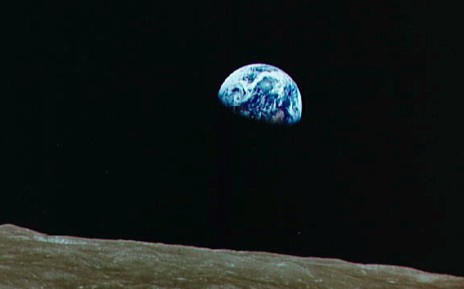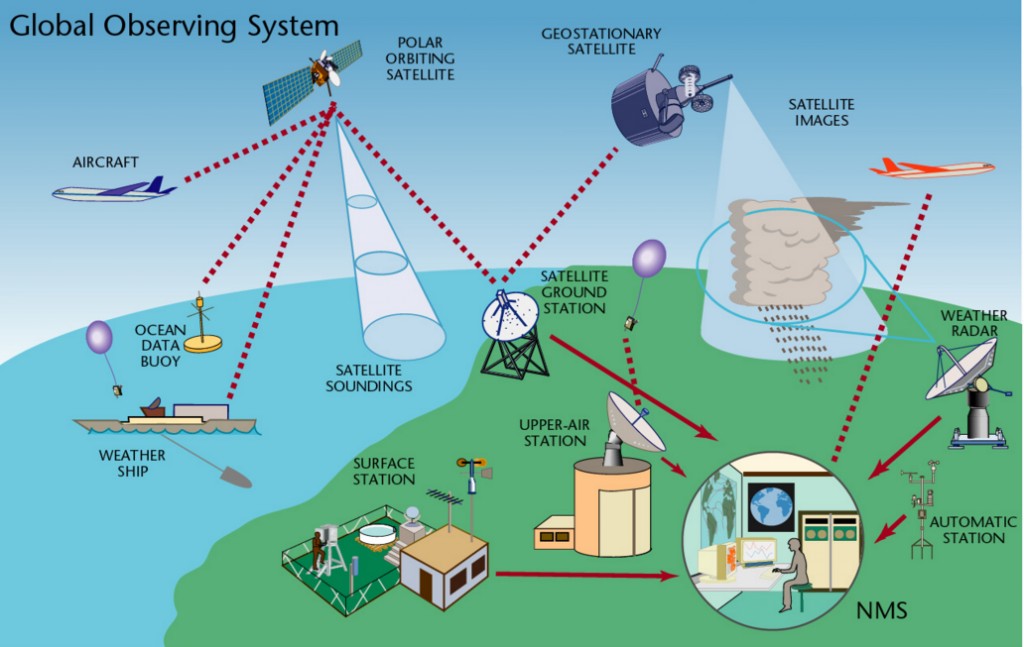
I’m off to the World Meteorological Organization at the end of the month for a workshop to help developing nations become more “Weather-Ready”. I would like everyone to be aware that the weather business is like a family, working together for the benefit of Society. This “Weather Enterprise” comprises all sectors: government, media, business, academia, non-profit organizations and volunteers:
Governments:
Governments provide the necessary infrastructure for effective weather services. The core observing systems depicted above are provided or enabled by government. This includes the most expensive systems like satellites and weather radar. The some 185 countries that are members of the World Meteorological Organization have agreed to openly share this data so that all countries (and the public) benefit collectively (even countries that don’t necessarily like each other share their weather data). We are fortunate that large countries like the USA fund the most expensive satellite missions, and make that data available to everyone, including the public.
Governments use the world’s most powerful computing systems to collect and analyse this data, and government scientists develop and run model simulations of the atmosphere that provide important guidance to meteorologists and climatologists. There are high resolution models (a few km or less), global models, and earth environmental models that couple the atmosphere with other parts of the earth system, like the oceans.
Government meteorologists also provide the core weather forecast and warning services. In particular, governments are the authoritative source of weather warnings issued for our protection and the protection of our property. The national weather services also work with other federal departments and provinces to provide services for public good. The best example of this is Emergency Management Organizations.
Media
Television, radio, print, and electronic media employ meteorologists and weather presenters to provide their audiences with tailored and value-added weather information. The media are important partners of the government weather services: they benefit from the core weather infrastructure; and the media help protect the public by disseminating the warnings issued by the national weather services.
Business
While the private media take advantage of the interest in weather for business purposes, there are numerous private companies that are involved in the weather enterprise. Certainly, the observing systems are developed by, or in partnership with the private-sector. Private weather companies employ meteorologists to provide specific services to other businesses or levels of government that are sensitive to the weather. Some of the sectors serviced include: transportation (aviation, rail, marine, and road) and energy (electricity generation and transmission).
Academia
Most universities have programs that include some aspects of weather and climate; and larger universities have dedicate atmospheric science programs. The universities play an important role in training new and existing meteorologists. Universities also conduct collaborative research programs that generates data and knowledge that advance the science of meteorology. The objective is largely for societal benefit.
Non-profit organizations
Scientific societies like the Canadian Meteorological and Oceanographic Society (CMOS), the Canadian Climate Forum, and others promote the advancement of science for improved public policy and public service. Consistent with this, our Halifax Chapter of CMOS are hosting a public lecture on weather and climate extremes on 27 February: https://cmos.in1touch.org/viewEvent.html?no_header=true&productId=7338
Volunteers
While the public have been involved at volunteer weather watchers or climate observers for years, smartphone and computing/telecom technology have made this easier in recent years. Crowdsourcing and Citizen Science (like cocorahs.org) enables almost any member of the public to share weather impact data between themselves and with the media and national weather services. The open availability of weather data on the internet has enabled weather enthusiasts to share their own weather information and forecasts. Public involvement in the Weather Enterprise ultimately makes everyone more weather-ready.
Gaps
The advancement in the science of meteorology has been nothing short of amazing, taking advantage of new technology and new understanding. However there is still much work to do:
- the cost of weather disasters is still rising. We need to do a better job of ensuring our communities and infrastructure are designed to be resilient to increasingly severe weather events.
- while there is an enormous amount of weather information available; but it needs to be packaged in a way that enables the public to understand the impacts and take appropriate action.
- flooding is one of the biggest impacts. Flood warnings are presently a provincial responsibility, and small provinces like Nova Scotia do not have the capacity to develop a flood forecast and warning program.
I’m lucky to still be active in each of these components of the Weather Enterprise, and committed to promoting actions that will help fill in some of the gaps.
stay safe
Jim




